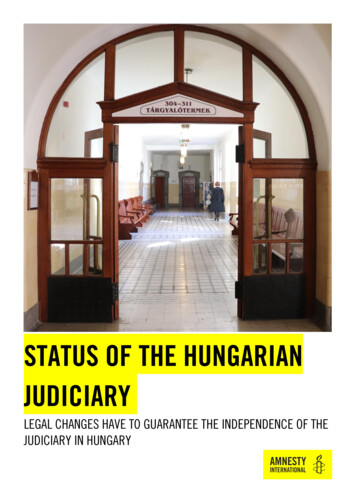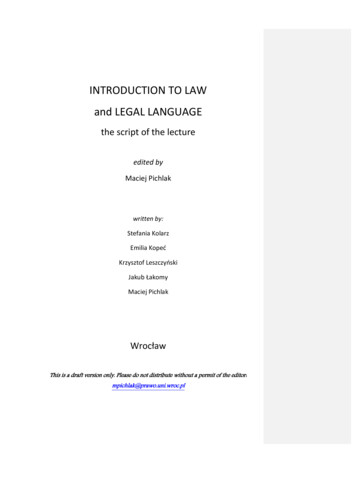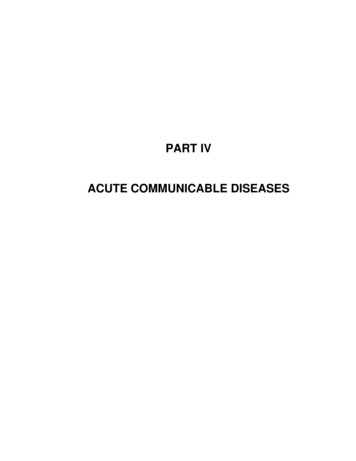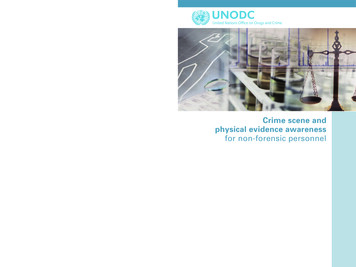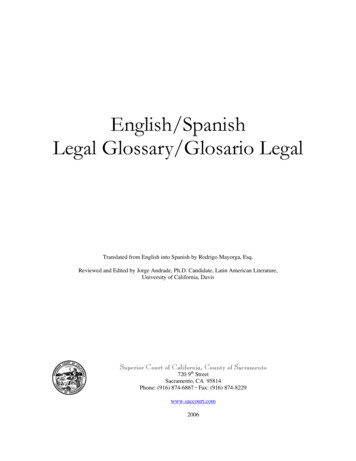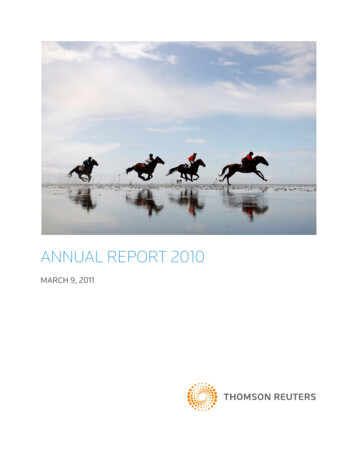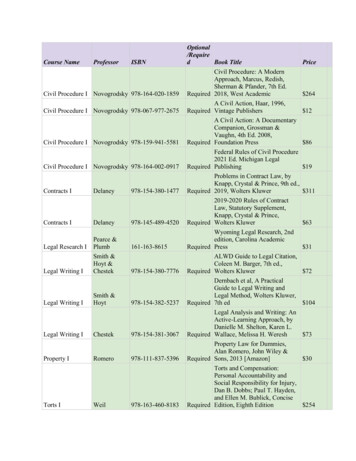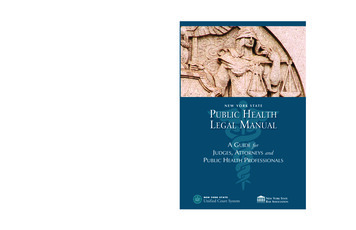
Transcription
FinalSpine width .2”N E W Y O R K S TAT EPUBLIC HEALTHLEGAL MANUALA GUIDE forJUDGES, ATTORNEYS andPUBLIC HEALTH PROFESSIONALSNEW YORK STATE UNIFIED C OURT SYS TEMNE W YORK S TATE BA R AS SOC IATIONN EW YORK STAT EDetail of the New York State Supreme Court, 80 Centre Street, NYC. Photograph by: Teodors ErmansonsUnified Court SystemNEW YORK STATEBAR ASSOCIATION
FinalSpine width .2”N E W Y O R K S TAT EPUBLIC HEALTHLEGAL MANUALA GUIDE forJUDGES, ATTORNEYS andPUBLIC HEALTH PROFESSIONALSNEW YORK STATE UNIFIED C OURT SYS TEMNE W YORK S TATE BA R AS SOC IATIONN EW YORK STAT EDetail of the New York State Supreme Court, 80 Centre Street, NYC. Photograph by: Teodors ErmansonsUnified Court SystemNEW YORK STATEBAR ASSOCIATION
N E W Y O R K S TAT EPUBLIC HEALTHLEGAL MANUALA GUIDE forJUDGES, ATTORNEYS andPUBLIC HEALTH PROFESSIONALSMICHAEL COLODNEREDITOR-IN-CHIEFNEW YORK STATEUnified Court SystemNEW YORK STATEBAR ASSOCIATIONIN COLLABORATION WITHNEW YORK CITYDEPARTMENT OF HEALTH AND MENTAL HYGIENE
New York State Bar Association Continuing Legal Education publications are intended to provide current and accurate information to help attorneys maintain their professional competence. Publications are distributedwith the understanding that NYSBA does not render any legal, accountingor other professional service. Attorneys using publications or orally conveyed information in dealing with a specific client’s or their own legal matters should also research original sources of authority.We consider the publication of any NYSBA practice book as the beginning of a dialogue with our readers. Periodic updates to this book will giveus the opportunity to incorporate your suggestions regarding additions orcorrections. Please send your comments to: CLE Publications Director,New York State Bar Association, One Elk Street, Albany, NY 12207.Copyright 2011New York State Bar AssociationAll rights reservedISBN: 1-57969-319-9Product Number: 4179ii
iii
FOREWORDChief Judge Jonathan Lippman:In today’s world, we face many natural and man-made catastrophicthreats, including the very real possibility of a global influenza outbreakor other public health emergency that could infect millions of people.While it is impossible to predict the timing or severity of the next publichealth emergency, our government has a responsibility to anticipate andprepare for such events. An important element of this planning process isadvance coordination between public health authorities and our judicialand legal systems. The major actors in any public health crisis mustunderstand the governing laws ahead of time, and must know what theirrespective legal roles and responsibilities are. What is the scope of thegovernment’s emergency and police powers? When may these beinvoked, and by which officials? What are the rights of people who maybe quarantined or isolated by government and public health officials?These questions must be researched and answered now—not in themidst of an emergency—so that the responsible authorities have a readymade resource to help them make quick, effective decisions that protectthe public interest. This New York State Public Health Legal Manual isdesigned to serve this purpose. It will be an absolutely essential tool inguiding us through the effective management of future public healthdisasters. I am pleased that the New York State Unified Court System wasable to play a key role in this historic collaboration along with the NewYork State Bar Association, the New York State Department of Health,and the New York City Department of Health and Mental Hygiene. Ithank each of these organizations for their invaluable cooperation andcontributions.Stephen P. Younger, President,New York State Bar AssociationOur vulnerability to public heath threats is more apparent than everbefore. Thus, it has become increasingly essential that public health officials, judges and lawyers be prepared to deftly navigate the myriad statutes and rules that govern public health disasters. This Manual, which isthe product of a collaborative effort, captures information gleaned frompast disasters and will serve as a tremendous resource for future needs.The New York State Bar Association is grateful for the excellent work ofv
the Office of Court Administration in producing this manual, and for thetremendous support from the New York State Department of Health andthe New York City Department of Health and Mental Hygiene, withoutwhich this Manual would not have been possible.vi
ACKNOWLEDGMENTSThe Committee gratefully acknowledges the assistance of Robert L.Burhans, former Director of the Office of Emergency Preparedness of theNew York State Department of Health, and Lawrence M. Martin, Esq., ofthe New York City Law Department, in the preparation of this Manual.Daniel McMahon, Esq., Kirsten Downer, Esq., Joan Fucillo, Lori Herzingand the staff at the New York State Bar Association ensured its timelypublication.vii
3][1.34]Foreword.Acknowledgments .I. Introduction .II. Applicable Law .A. New York Public Health Law .B. State Sanitary Code .C. Laws of the City of New York.D. Local Ordinances .III. Jurisdiction Over Public Health Issues.A. Local Health Officers.1. Identity .2. Responsibilities .B. State Commissioner of Health .C. Federal Government.IV. Isolation and Quarantine .A. Definitions.1. State Sanitary Code .a. Isolation .b. Quarantine .2. New York City Health Code .a. Isolation .b. Quarantine .B. Communicable Diseases Covered.C. Identification and Reporting of CommunicableDiseases.1. Physician .2. Laboratory .3. Local Health Officer .D. Authority to Isolate .1. Physician .2. Local Health Officer .E. Authority to Quarantine .F. Voluntary Isolation and Quarantine .G. Involuntary Isolation and Quarantine:Constitutional Standards .1. Substantive Due Process .2. Procedural Due Process.H. Involuntary Isolation and Quarantine: Issuance ofHealth Order by Local Health Officer .1. Authority 1515
Standard for Health Order .Contents of Health Order .Duration of Health Order .Enforcement of Health Order.a. Civil Enforcement.b. Criminal Enforcement .I. Involuntary Isolation and Quarantine:Issuance of Court Order .[1.42]1. Authority .[1.43]a. Public Health Law .[1.44]b. New York City Health Code .[1.45]c. Habeas Corpus.[1.46]d. Article 78 Review.[1.47]2. Standard of Review .[1.48]3. Right to Counsel.[1.49]4. Subsequent Judicial Retention Orders.[1.50]5. Costs of Isolation and Quarantine .[1.51]J. Provisions Covering Isolation and Quarantinefor Specific Diseases .[1.52]1. Tuberculosis .[1.53]2. Venereal [Sexually Transmissible]Diseases.[1.54]3. Typhoid .[1.55]4. Diphtheria.[1.56] V. Mandatory Examination and Treatment.[1.57]A. Authority .[1.58]1. Examination .[1.59]2. Treatment .[1.60]B. Constitutional Restraints: Examinations .[1.61]C. Constitutional Restraints: Treatment.[1.62] VI. Inspections and Seizures of Property .[1.63]A. Authority .[1.64]1. Public Health Law[Communicable Disease] .[1.65]2. State Sanitary Code[Communicable Disease] .[1.66]3. New York City [Communicable Disease].[1.67]4. Public Health Law [Nuisance] .[1.68]5. New York City [Nuisance].[1.69]6. Eminent Domain; Public Health Law .[1.70]B. Constitutional Restraints .[1.71]1. Fourth Amendment: Searches and 2728282828293133333334343435363838
04]2.Fourteenth Amendment: ProceduralDue Process.3. Fifth Amendment; State Constitution,Article I, Section 7(a): Just Compensationfor Seized Property.VII. Control of Domestic Animals with DiseasesAffecting Humans .A. Agriculture and Markets Law [AML].1. Searches and Seizures .2. Vaccination .3. Quarantine .4. Destruction of Animals Exposed toDisease .B. New York City Health Code .1. Reports .2. Investigation.3. Seizure and Isolation .4. Destruction .VIII. Emergency Responses to Disasters .A. Authority .1. Executive Law [Exec. Law].a. Role of Localities .(i) Local Disaster Emergency Plans .(ii) Local Responses to Disasters.(iii)Local Use of Disaster EmergencyResponse Personnel .(iv)Local States of Emergency andSuspension of Local Laws .b. Role of the State .(i) State Disaster Preparedness Plans.(ii) State Declaration of DisasterEmergency .(iii)Suspension of Laws.2. Additional Statutory Authority forNew York City .3. State Defense Emergency Act [SDEA].a. Civil Defense Plans .b. Response to an “Attack”.c. Allocation of Resources in Disasters.C. Statutory Immunity From Liability.1. State Defense Emergency Act.2. Executive 4949505051515254565656
[1.105]3.Federal Public Readiness and EmergencyPreparedness Act .[1.106]4. Federal Volunteer Protection Act.[1.107] IX. Confidentiality of Patient Records .[1.108]A. New York Authority.[1.109]1. Patient Records Maintained by HealthCare Providers .[1.110]2. Patient Information Contained in Recordsof Public Agencies .[1.111]B. Health Insurance Portability and AccountabilityAct of 1996.[1.112]1. Application to Public Health Officials .[1.113]2. Application to Court Records.[1.114]C. Constitutional Right of Privacy.[1.115] X. Operation of Courts Amid Public Health Threats .[1.116]A. Emergency Relocation of Court Terms.[1.117]1. Authority to Relocate .[1.118]2. Applicable Law in Relocated Courts .[1.119]3. Cost.[1.120]B. Case Management in Emergencies .[1.121]1. Authority of Court Administrators.[1.122]2. Authority of Judge.[1.123]3. Authority of Governor.[1.124]C. Remote Appearances.[1.125]1. Legislative Authorization.[1.126]2. Authority of Judge.[1.127]D. Protection of Court Personnel .[1.128] XI. 070707273Table of Authorities. 75Committee Member Biographies. 87xii
NEW YORK STATE PUBLIC HEALTH LEGAL MANUAL[1.0]§ 1.0I. INTRODUCTIONRecent outbreaks of potentially deadly communicable diseases, as wellas a growing awareness of society’s vulnerability to deliberate threats topublic health, have required that greater attention be paid to the legalissues governing the handling of public health disaster emergencies.Many of the statutes governing responses to public health emergencieshave not been revised for decades, and the application of those statutes toa contemporary world has become more complicated. This Legal Manualis an effort to assist judges, lawyers, and public health officials and practitioners in sorting through the myriad statutes and rules governing publichealth, and in applying the overriding constitutional principles that balance individual rights with societal health requirements.The Manual addresses the laws governing control of the spread ofcommunicable diseases and the laws governing abatement of nuisances,such as radiological and chemical contamination, that may cause publichealth emergencies. It does not specifically address statutes governing airand water pollution, but the principles discussed can be readily applied topublic health emergencies from those sources as well.Because the statutes and rules governing responses to public healthemergencies contain gaps, and because the application of these statutes isfraught with constitutional issues, the Manual contains “commentary”sections that discuss how the existing law may be applied to these publichealth issues. These commentaries, as well as any constitutional analysispreceding the commentaries, are solely the views of the authors and areintended to be helpful, not definitive. Judges, of course, ultimately maketheir own decisions of how the law should apply.One of the anomalies of the New York Public Health Law is that manyof its provisions governing control of contagious diseases and nuisancesdo not apply to New York City. Consequently, where appropriate, theManual contains separate references to the provisions of the New YorkCity Health Code, New York City Charter and New York City Administrative Code that address these areas. The New York City provisions arealmost always consistent with the Public Health Law provisions.1
§ 1.1NEW YORK STATE PUBLIC HEALTH LEGAL MANUAL[1.1]II. APPLICABLE LAW[1.2]A. New York Public Health LawArticle 21 of the New York Public Health Law [PHL], supplementedby Articles 22 and 23 addressing specific diseases, governs the control ofcommunicable diseases within the state. Article 13 of the PHL governsthe handling of nuisances that affect the public health. The PHL also setsforth the roles of the officials who exercise the authority under both Articles. With very limited exceptions (PHL §§ 2130 et seq. [HIV/AIDSreporting]; 2164 [immunizations]), the provisions of these Articles do notapply to New York City (see C, below).[1.3]B. State Sanitary CodeThe State Sanitary Code is part of the rules of the New York StateDepartment of Health and is contained in Volume 10 of the New YorkCompilation of Codes, Rules and Regulations [NYCRR]. The SanitaryCode is a set of rules established by the state Public Health and HealthPlanning Council for general application throughout the state relating tothe preservation and improvement of public health, including the controlof communicable diseases. See PHL §§ 220 [membership of Council];225(1), (4), and (5)(e), (g)-(k) [power to establish Sanitary Code, including power to designate communicable diseases dangerous to the publichealth and to promulgate certain control measures]. All provisions of theState Sanitary Code must be approved by the State Commissioner ofHealth. PHL § 225(4). The Code applies statewide, including New YorkCity, and supersedes all inconsistent local ordinances, although localitiesmay enact sanitary regulations not inconsistent with the Code. PHL§ 228(1) and (2). Provisions of the State Sanitary Code have the force andeffect of law. PHL § 229.[1.4]C. Laws of the City of New YorkThe provisions of the Public Health Law governing nuisances (Article13) and communicable diseases (Article 21) for the most part do not applyto New York City. PHL §§ 1309, 2110, 2125, 2146, 2153. Instead, the authority to regulate both is contained in various sources of New York Citylaw. Notably, section 556 of the New York City Charter provides the New2
NEW YORK STATE PUBLIC HEALTH LEGAL MANUAL§ 1.5York City Department of Health and Mental Hygiene with the authority to“regulate all matters affecting health in the city of New York and to perform all those functions and operations performed by the city that relate tothe people of the city.” (The New York City Department of Health andMental Hygiene will be referred to throughout this Manual as the “CityDepartment of Health,” and the Commissioner of that Department will bereferred to as the “City Commissioner of Health.”) Section 556(c) of theCharter authorizes the Department to supervise the reporting and controlof communicable diseases and conditions hazardous to life and health, aswell as to exercise control over and supervise the abatement of nuisancesaffecting or likely to affect the public health. In accordance with sections558(b) and (c) of the Charter, the New York City Board of Health maypromulgate and amend the City Health Code. The City Board of Healthhas promulgated Articles 3 and 11 of the Health Code, contained in Title24 of the Rules of the City of New York [RCNY], to address the controlof, respectively, nuisances and communicable diseases within New YorkCity.[1.5]D. Local OrdinancesEnforcement of the communicable disease and nuisance provisions ofthe Public Health Law and the State Sanitary Code is primarily the role oflocal health officers. Their actions are governed by local ordinances to theextent that the Public Health Law and Sanitary Code do not apply. Manyless-populated counties are served by a district or regional office of theState Department of Health, whose role is limited to enforcement of theSanitary Code and other environmental health regulations. See, e.g., 10NYCRR Parts 70-75. In such areas, the Department rules governing procedures for investigation and enforcement of public health laws by stateofficers apply. See 10 NYCRR Part 76.CommentaryEnforcement of the provisions of the Public Health Law and StateSanitary Code governing threats to public health is primarilyaddressed at the local level. The provisions of the Public Health Lawleave to local government how local enforcement should be handled,especially with respect to the administrative process for regulating3
§ 1.6NEW YORK STATE PUBLIC HEALTH LEGAL MANUALenforcement. The result is a multiplicity of enforcement proceduresamong the localities that are contained in local ordinances. For themost part, the provisions of the Public Health Law governing contagious disease, and many of the provisions governing nuisances, donot apply to New York City; New York City enforcement proceduresare codified in the City Health Code in Title 24 of the Rules of theCity of New York.[1.6]III. JURISDICTION OVER PUBLIC HEALTH ISSUES[1.7]A. Local Health Officers[1.8]1. IdentityA “local health officer” can be (1) the commissioner of health of acounty or a city having a population of 50,000 or more and having anestablished health department; (2) a public health director (a person whoadministers and manages the public health programs within a county);(3) a county health director appointed pursuant to PHL § 356 in countieshaving a population of less than 150,000, but no charter or optional oralternative form of government; and (4) the officer of a city having a population of less than 50,000, a town, a village or a consolidated health district who administers and manages public health programs within suchjurisdiction. See 10 NYCRR § 11.1. Local boards of health may consist ofthe boards of health of a county or a part-county health district, or theboard of trustees of a village or the town board, depending upon how locallegislators address this structure. See PHL §§ 302, 308, 340, 356. See also10 NYCRR § 2.2(e) [Sanitary Code definition of “local health authority”—authority of a county, part-county, city, town, village, consolidatedhealth district . . .”]. But see Commentary, below. New York City: Theprovisions of Article 3 of the Public Health Law governing local healthofficers for the most part do not apply to New York City. PHL § 312. The“local health officer” in New York City is the City Commissioner ofHealth. New York City Charter § 551.[1.9]2. ResponsibilitiesLocal health officers have the statutory authority to “enforce” theprovisions of the Public Health Law and the State Sanitary Code. PHL4
NEW YORK STATE PUBLIC HEALTH LEGAL MANUAL§ 1.10§ 324(1)(e). They are required to “immediately investigate” any outbreaksof contagious diseases, 10 NYCRR § 2.16(a), and to make an “immediateand thorough” investigation of “a nuisance which may affect health.” 10NYCRR § 8.1. Parallel authority of the New York City HealthCommissioner with respect to nuisances and diseases is contained,respectively, in Articles 3 and 11 of the New York City Health Code[24 RCNY]. The initial implementation of all the provisions of lawrelating to isolation, quarantine, examinations, treatment, and searchesand seizures is the responsibility of the local health officer. See Grossmanv. Baumgartner, 17 N.Y.2d 345 (1966) [“the main business of safeguarding the public health has always of necessity been done by localboards or officers through sanitary by-laws or ordinances which havebeen accorded the force of law”].[1.10]B. State Commissioner of HealthThe State Commissioner of Health exercises general supervision overlocal health officers. PHL § 206(1)(b) [“general supervision over the workof all local boards of health and health officers, unless otherwise providedby law”]. The State Commissioner (a) monitors the control of contagiousdiseases by the local health officers through the requirement that all suchdiseases be reported by the local health officers to the State Commissioner, 10 NYCRR § 2.16(a); PHL § 2103; (b) monitors control of publicnuisances through reports filed with the State Commissioner of those nuisances that have been reported by health officers but that are not beingaddressed, 10 NYCRR § 8.4; and (c) retains the reserved power to intervene directly in a health crisis to enforce the Public Health Law and StateSanitary Code. PHL § 206(1)(f) [State Commissioner shall “enforce” thePHL and Sanitary Code]; PHL § 16 [State Commissioner may issue apublic health order where a condition “constitutes danger to the health ofthe people”]. See also PHL §§ 1301 [when required by the Governor, theState Commissioner “shall make an examination concerning nuisances orquestions affecting the security of life and health in any locality”]; 1302[the board of health of any health district “may appoint one of its members to act with and assist the commissioner during the investigation orexamination of any nuisance”].5
§ 1.11[1.11]NEW YORK STATE PUBLIC HEALTH LEGAL MANUALC. Federal GovernmentThe federal government generally leaves to the states regulation ofpublic health issues through the exercise of the police powers of the individual states. It retains residual authority under the Commerce Clause ofthe United States Constitution to enact laws to control the spread of communicable diseases between states. See 42 U.S.C. § 264 [the federal government controls movement of persons into the United States to preventthe spread of communicable diseases and may control persons “movingbetween states” for that purpose]. The federal Centers for Disease Controland Prevention can take measures to prevent the spread of diseasebetween states if local efforts are “insufficient.” 42 CFR § 70.2. See also42 U.S.C. §§ 5121 et seq. (the Stafford Act) [Federal Emergency Management Agency (FEMA) can implement health and safety measures after afederal declaration of emergency]. The Food and Drug Administration(FDA) regulates drug-based treatments and the circumstances of their use,and federal legislation (see VIII(C)(3), infra) regulates medical recordsand provides immunity with regard to vaccinations and drugs used inresponse to denominated public health emergencies.CommentaryControl of public health is primarily handled on a local level. Ideally, local health departments and officers are staffed and equippedto be the first line of defense for control of disease outbreaks andother public health emergencies. The State Commissioner of Healthis kept informed by local health authorities of outbreaks of communicable diseases and other public health concerns, but exercises primarily a monitoring and resource role, providing technicalassistance, epidemiologic analysis, laboratory testing and often onsite assistance in dealing with disease outbreaks. The State Commissioner retains the reserved power to step in to exercise an active rolewhere local intervention is inadequate. Although the Public HealthLaw and Sanitary Code provide (outside of New York City) for theestablishing of local health officers below the county level, in actuality no such positions are operative. State health officials rely exclusively on county health officers as their link to city, town and villagegovernments.6
NEW YORK STATE PUBLIC HEALTH LEGAL MANUAL[1.12]IV. ISOLATION AND QUARANTINE[1.13]A. Definitions[1.14]1. State Sanitary Code[1.15]a. Isolation§ 1.1210 NYCRR § 2.25(d) [“separation from other persons, in such places,under such conditions, and for such time, as will prevent transmission ofthe infectious agent, of persons known to be ill or suspected of beinginfected”].[1.16]b. QuarantineQuarantine of premises: 10 NYCRR § 2.25(e) [(1) “prohibition ofentrance into or exit from the premises, as designated by the healthofficer, where a case of communicable disease exists of any person otherthan medical attendants and such others as may be authorized by thehealth officer; (2) prohibition, without permission and instruction fromthe health officer, of the removal from such premises of any article liableto contamination with infective material through contact with the patientor with his secretions or excretions, unless such article has been disinfected”]. Personal quarantine: 10 NYCRR § 2.25(f) [“restricting household contacts and/or incidental contacts to premises designated by thehealth officer”].[1.17] 2. New York City Health Code[1.18]a. IsolationHealth Code [24 RCNY] § 11.01(o) [“the physical separation of persons who have a contagious disease or are suspected of having a contagious disease from other persons who do not have such contagiousdisease”].[1.19]b. QuarantineHealth Code [24 RCNY] § 11.01(q) [“the physical confinement, separation, detention, or restriction of activities, including entry or e
public health legal manual a g uide for judges, a ttorneys and public health professionals new york state new york state un ified court system new york state d ˆa ˆ n y sˆaˆ s c ˆ, 80 c ˆ sˆ ˆ, nyc. photograph by: t ˇ e
